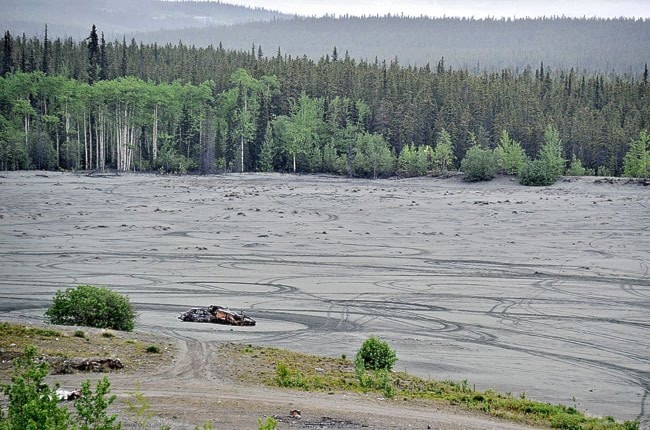Eagle Industrial Minerals Corp. is one step closer to mining magnetite from the iron-rich tailings at the old Whitehorse Copper mine site.
The Yukon Water Board issued an industrial water licence to the company this week. The licence is the final permit the company needs to begin operations. The Yukon Environmental Socio-economic Assessment Board has already approved the project.
The company plans to scoop up the tailings at the site and mix them with water to create a slurry. The mixture will then be poured into giant drums lined with magnets to draw out the magnetite.
This will require 27,700 cubic metres of water a day. That’s more than enough to fill 11 Olympic-sized swimming pools. Much of the water will be recycled, but the company will still need to draw water daily from Little Chief Pit Lake on site, or a well.
The property is about eight kilometres south of the city’s downtown. The former copper mine operated from 1967 to 1982. In the 1970s, City of Whitehorse boundaries were expanded to include the site.
Over the last three decades, rural subdivisions have sprung up around the former mine. Area residents have expressed concerns about contaminants leaching into their groundwater as a result of Eagle’s project. Many of the country-residential properties nearby receive drinking water from wells. While the 10 million tonnes of tailings on site are about 20 per cent magnetite, they’re also full of toxic metals like selenium, molybdenum, arsenic, uranium and copper.
YESAB had flagged the potential of contaminants leaching into the water as a concern. There were concerns new work on the old mine site may stir up contaminants.
Most of the contamination on the site has already happened, said Lewis Rifkind, mining co-ordinator for the Yukon Conservation Society. The chance for contaminants getting into groundwater is greatest when there’s crushing happening, he said. And there won’t be any new crushing occurring at the site.
And the licence contains measures to monitor any potential contaminants.
This licence requires there to be 10 groundwater testing wells on the site, which is more than at most mine sites, said Rifkind. The site is fairly small compared to most other mines, he said. But it sprawls over a lot of land.
“If we start to see contamination in the groundwater, or going out of the mine site, we’ll have an early heads up,” he said.
The company needs to submit annual reports beginning in February. The licence also requires the company to study how long it takes groundwater to travel from Little Chief Pit Lake to three of the wells on site.
The licence is “adequate” and comparable to other licences, said Rifkind.
Under the licence, the levels of arsenic in the water can’t exceed 0.025 milligrams per litre while the site is operating. Uranium levels can’t be higher than 0.02 milligrams per litre. Mercury levels must be below 0.001 milligrams per litre.
The society has no major concerns with the licence, although it would have been nice to see a higher security deposit, said Rifkind. The licence sets the deposit at just over $1.8 million.
The company hopes to start work late this summer at the earliest, said president Chuck Eaton. It still needs to drill more water monitoring wells. The biggest challenge will be getting all the equipment ordered and built.
The company’s water licence expires in 2028.
Contact Meagan Gillmore at mgillmore@yukon-news.com
